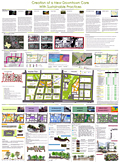MLA students' downtown core concept wins Texas ASLA award
A College Station area consisting of strip malls and parking lots would become a pedestrian-friendly, mixed-use, downtown core in an award-winning master plan proposed by Master of Landscape Architecture students at Texas A&M.
The plan earned a Merit Award from the Texas chapter of the American Society of Landscape Architects at its April 5-6 conference in Grapevine, Texas.
“Your work stood above the rest,” said Texas ASLA’s Brad Moulton.
The students, Cong Bian, Yuxi Cheng, Lingyan Miao, Jeffrey Slater, Qian Wan, Qingshu Wang and Wenjie Zhao, produced the plan in a summer 2011 studio led by Bruce Dvorak, assistant professor of landscape architecture.
The students’ proposal covers an area bordered by Texas Avenue, Dominic Street, George Bush Drive East and Holleman Drive and includes a section of Harvey Road.
The team sought to improve the space in five ways:
- Transportation: by increasing pedestrian accessibility, limiting vehicle speeds and encouraging the use of public transportation;
- Social space: by creating areas for walking, biking, gathering and eating;
- Stormwater management: by installing bioswales — landscape elements used to collect and treat runoff — rain gardens and porous asphalt;
- Wildlife habitat: by preserving the Wolf Pen Creek habitat and installalling green roofs and rain gardens, and
- Mitigation of the urban heat island effect: by reducing the quantity of paved surfaces, installing green roofs and green walls, and using building materials with low reflectivity.
They design included pedestrian-scaled city blocks, a mix of businesses and loft dwellings and two pedestrian-only areas. The plan also revitalized and increased access to Wolf Pen Creek and removed the pavement from a stream that runs through a section of the proposal.
“Our plan’s benefits include improved pedestrian and public transportation, increased wildlife habitat areas, reduced storm water runoff times, reduced urban heat island effects, and increased living/commercial/retail space,” said the students in a project summary. “We achieved the goal of creating a new downtown core for College Station while increasing the sustainability of the site that will benefit users for many years to come.
Previous post
Next Post
Tags
- building a better texas
- competitions
- graduate work
- honors
- land development
- landscape architecture & urban planning
- laup gallery
- planning
- rss
- studio projects
- sustainability
- transportation
- wellness
Related Posts

Student's project showcased on international blog

LAND student’s concept earns coveted award

Grad LAND students design green West Campus master plan

Texas APA honors grad students' plan for Gonzales, Texas
Follow Us
Facebook Twitter Vimeo Youtube Flickr RSS
Recent Posts

Planning prof heads study of disaster housing aid

A message from the dean

Former student remembered as expert planner

Leading educator named new head of Architecture Dept.







_thumbnail_small.png)
